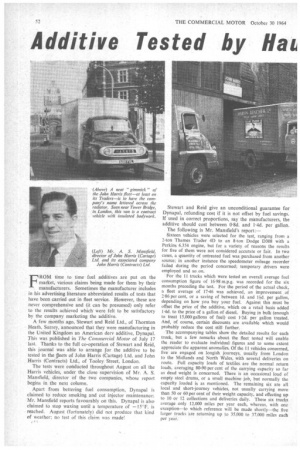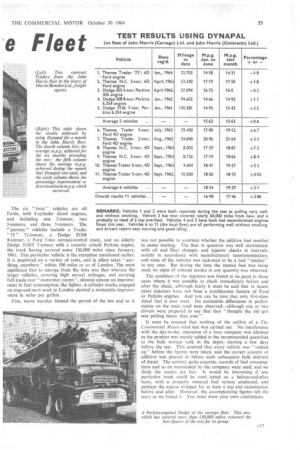Additive Tested by HaL e Fleet
Page 54

Page 55

If you've noticed an error in this article please click here to report it so we can fix it.
FROM time to time fuel additives are put on the market, various claims being made for them by their manufacturers. Sometimes the manufacturer includes in his advertising literature abbreviated results of tests that have been carried out in fleet service. However, these are never comprehensive and (it can be presumed) only refer to the results achieved which were felt to be satisfactory by the company marketing the additive.
A few months ago, 'Stewart and Reid Ltd., of Thornton•Heath, Surrey, announced that they were manufacturing in the United Kingdom an American dery additive, Dynapal. This was published in The Commercial Motor of July 17 . last. Thanks to the full co-operation of Stewart and Reid, this journal was able to arrange for the additive to be tested in the pees of John Harris (Cartage) Ltd. and John Harris (Contracts) Ltd., of Tooley. Street, London.
The tests were conducted throughout August on all the Harris vehicles, under the close supervision of Mr. A. S. Mansfield, director of the two companies, whose report begins in the next column.
Apart from bettering fuel consumption, Dynapal is claimed to reduce smoking and cut injector maintenance; Mr. Mansfield reports favourably on this. Dynapal is also claimed to stop waxing until a temperature of —15°F. is reached. August (fortunately) did not produce that kind of weather; no test of this claim was made! Stewart and Reid give an unconditional guarantee for Dynapal, refunding cost if it is not offset by fuel savings. If used in correct proportions, say the manufacturers, the additive should cost between 0.8d. and 1-4d. per gallon. The following is Mr. Mansfield's report:— Sixteen vehicles were selected for the test, ranging from a 2-ton Thames Trader 4D to an 8-ton Dodge D308 with a Perkins 6.354 engine, but for a variety of reasons the results for five of them were not considered accurate or fair. In two cases, a quantity of untreated fuel was purchased from another source; in another instance the speedometer mileage recorder failed during the period concerned; temporary drivers were employed and so on.
For the 11 trucks which were tested an overall average fuel consumption figure of 16.98 m.p.g. was recorded for the six months preceding the test. For the period of the actual check, a fleet average of 17-46 was achieved, an improvement of 2.86 per cent, or a saving of between Id. and 14d. per gallon, depending on how you buy your fuel. Against this must be offset the price of the additive, which on a retail basis added 1.4d. to the price of a gallon of diesel. Buying in bulk (enough to treat 15,000 gallons of fuel) cost 1.2d. per gallon treated. Mid, of course, certain discounts are available which would probably reduce the cost still further.
The accompanying tables show the detailed results for each truck, but a few remarks about the fleet tested will enable the reader to evaluate individual figures and to some extent appreciate the apparent anomalies. Of the 11 vehicles concerned, five are engaged on longish journeys, usually from London to the Midlands and North Wales, with several deliveries on route. Full capacity loads of textiles are the normal return loads, averaging 80-90 per cent of the carrying capacity so far as dead weight is concerned. There is an occasional load of empty steel drums, or a small machine job, but normally the capacity loaded is as mentioned. The remaining six are all local and short-journey vehicles, not usually carrying more than 50 or 60 per cent of their weight capacity, and effecting up to 10 or 12 collections and deliveries daily. These six trucks average only 12,000 miles per year each, whereas, with one exception—to which reference will be made shortly—the five larger trucks 'are returning up to 35,000 to 37.000 miles each per year.
The six "local " vehicles are all Fords, with 4-cylinder diesel engines, and including one 2-tonner, two 3-tonners, and three 5-tonners. The " journey " vehicles include a Trader " 75 " 71-tonner, a Dodge D308 8-tonner, a Ford 5-ton normal-control truck, and an elderly Dodge 3136T 7-tormer with a recently rebuilt Perkins engine, the truck having covered some 130,000 miles since January, 1961. This particular vehicle is the exception mentioned earlier. It is employed on a variety of tasks, and in effect takes "anything, anywhere" within 100 miles or so of London. The most significant fact to emerge from the tests was that whereas the larger vehicles, covering high annual mileages, and carrying full loads over "motorway routes ", showed almost no improvement in fuel consumption, the lighter, 4-cylinder trucks engaged on stop-and-start work in London showed a noticeable improvement in miles per gallon.
Fine, warm weather blessed the period of the test and so it
was not possible to ascertain whether the additive had resulted in easier starting. The fleet in question was well maintained, with oil and filter changes, and injector checks at intervals, strictly in accordance with manufacturers' recommendations. and none of the vehicles was reckoned to be a bad "smoker in any case. But during the time the treated fuel was being used, no signs of exhaust smoke in any quantity was observed.
The condition of the injectors was found to be good in those eases where it was possible to check immediately before and after the check, although fairly it must be said that in recent years injectors have not been a troublesome feature of Ford or Perkins engines. And you can be sure that only first-class diesel fuel is ever used. No noticeable differences in performance on the main road were observed—although one or two drivers were prepared to say that they "thought the old girl was pulling better than ever ".
It must be stressed that nothing of the calibre of a The Cominereial Motor road test was carried out. No interference with the day-to-day operation of a busy company was allowed as the product was merely added in the recommended quantities to the bulk storaize tank in the depot, starting a few days before the test. This ensured that every vehicle was "tanked
" before the figures were taken, and the correct amount of additive was poured in before each subsequent bulk delivery of diesel. The normal, quite accurate, records of fuel consumptions and so on maintained by the company were used, and we think the results are fair. It would be interestine if one particular truck could be road tested on a before-and-after basis, with a properly metered fuel system employed, and perhaps the engine stripped for at least a top end examination before and after. However, the accompanyine figures tell the story as we found it. You must draw your own conclusions.












































































































